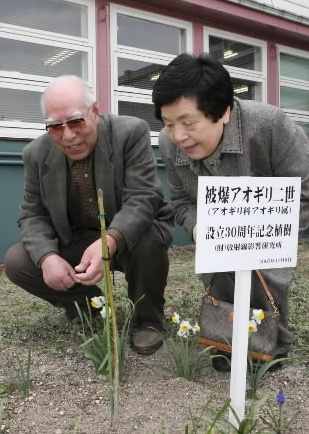Special Series: 60 Years of RERF, Part I [5]
Jun. 30, 2010
Moving beyond its past: Integration into the local area
by Hiromi Morita, Staff Writer
This feature series on the past and future of the Radiation Effects Research Foundation (RERF) originally began to appear in the Chugoku Shimbun in February 2007.
Seeking to clarify the A-bomb damage
A 60-centimeter tall seedling stands in the compound of the Radiation Effects Research Foundation (RERF) in Minami Ward, Hiroshima. This is a second-generation Chinese Parasol Tree, which has budded from the seed of an A-bombed tree. RERF staff members have planted narcissuses around the seedling and are tending to its growth.
"The trunk seems to have grown a bit bigger," said Hisao Miyama, 82, and his wife Fumiko, 79. They are A-bomb survivors (hibakusha) who have continued to participate in the adult health study conducted by RERF. In 2005, on the 30th anniversary of the reorganization of the Atomic Bomb Casualty Commission (ABCC), RERF's predecessor, to the current institute, the couple was invited to the commemorative ceremony and helped plant the seedling.
Through its research, RERF has accumulated data with the support of a large number of hibakusha, such as Mr. and Mrs. Miyama, and its research results have earned the institute an international reputation. At the same time, there is lingering distrust of RERF locally due to feelings that heavy-handed surveys were conducted by ABCC and the fact that the U.S. Department of Energy (DOE), charged with U.S. nuclear weapons development, holds jurisdiction over the institute.
Hibakusha have filed lawsuits against the Japanese government in class action lawsuits over A-bomb disease certification. While these lawsuits are not directly linked to RERF, "probability of cause," the government's yardstick for A-bomb disease certification criteria, has been, ironically, calculated from RERF's data accumulated through surveys on survivors.
Though the application of "probability of cause" was rejected in a series of rulings issued by district courts, the government has still clung to this yardstick and appealed the rulings to higher courts. Toshiteru Okubo, chairman of RERF, pointed out, "Some people are more resistant to radiation than others. Even if people are exposed to the same amount of radiation, some will not suffer the effects of that radiation. Though we might be able to prove the possibility to be high or low, through scientific means, we cannot state with assurance that no possibility exists. That is why lawsuits are being fought." RERF, which is under the jurisdiction of the Ministry of Health, Labour and Welfare, takes a different stance to the Japanese government, holding the view that "Science and a social perspective are two different things. What is now in question is how the society should extend relief to hibakusha."
Since the institute's reorganization in 1975, RERF has convened the Hiroshima Local Liaison Council, comprised of local hibakusha, local government officials and medical experts, and continued dialogues to shake off the impressions created by ABCC. Sunao Tsuboi, 81, co-chairperson of the Japan Confederation of A- and H-bomb Sufferers Organizations, joined the council four years ago. He underwent a bitter experience more than half a century ago when he was stripped naked and subjected to a thorough examination, but received no explanation from the institute. "I was treated like an animal," Mr. Tsuboi recalls. Upset over the experience, he stopped visiting the institute.
"Hibakusha tend to think that everything is the result of radiation," said Mr. Tsuboi. "This is why conveying the thoughts of hibakusha to the institute and, vice versa, arranging opportunities for the institute to explain the most current scientific knowledge to hibakusha are so important."
RERF was born amid mixed feelings that prevailed among Hiroshima citizens under the occupation of the nation which dropped the atomic bombs. The institute has since grown through considerable trial and error in its practices. "Hibakusha and the research that could be accumulated thanks to their cooperation must be linked," said Dr. Okubo with regret. As one such effort, RERF revised its brochure for citizens in 2005 so that the current work of RERF will be more broadly known. The RERF Secretariat has also established the Public Relations and Publications Office, which provides public relations functions.
The whole picture of the damage caused by the atomic bombing has not yet been fully illuminated. The genetic effects of radiation on the human body and low-dose radiation exposure, in particular, have remained an enigma. "As long as our data is stored here, we want it to be properly used for our children's generation," said Mr. and Mrs. Miyama, tying this wish to the Chinese Parasol Tree with the hope that both the seedling and RERF will firmly take root in Hiroshima soil and spread their limbs and leaves to the next generation.
(Originally published on March 3, 2007)








